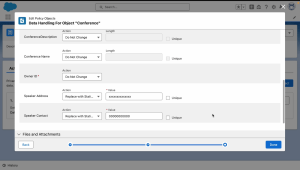In banking, data governance is about meeting both regulatory and internal requirements. Find out what’s required of your data governance plans by reading this guide.

As most companies today face remarkable data overload, the importance of effective data governance frameworks continues to grow. Banks in particular need to derive value from data for both the innovation and modernization of their operations as well as for continued compliance and ethical management of the data they work with. In this guide, we cover the details of how and why banks can benefit from a strong data governance framework.
Jump to:
How does data governance work in banking?
Today’s economic landscape requires most if not all industries to enhance their data-driven capabilities in the market to maintain a competitive edge. The banking sector is no exception. The introduction of data governance models in banking gives banks the resources they need to upgrade their current procedures and policies to improve their data protection mechanisms.
SEE: Hiring Kit: Database engineer (TechRepublic Premium)
Data governance specifications also improve banks’ data analysis capabilities for better decision-making. Data governance in banking means delivering tools for the banking sector to not only optimize its effectiveness and innovation but also support risk management and regulatory reporting.
What does a data governance program include?
A data governance program frequently involves:
- Installing data format standards.
- Pinpointing data that requires protection.
- Tagging data types and assigning roles and responsibilities.
- Setting up metrics to quantify the effectiveness of the governance program.
- Infusing automation.
- Using metrics-based programs to assess, identify, monitor and improve the governance program.
Ways data governance provides value in banking
Regulatory compliance
It is a requirement for banks to keep all the data they have secure, based on a variety of federal and state compliance regulations. Regulatory requirements continue to pressure the banking industry to get data governance under control as the consequences of data violations become more costly.
With the right data governance plan in place, banks always know exactly what data they have access to. They also always know where data is located, which ensures they can enforce the right controls — even during complicated projects like cloud migrations.
Awareness of the location of data, the regulations it is liable to and the correct approach to protection is key for successful cloud migration and other digital transformation projects. Data governance provides pertinent tagging to ensure banks satisfy regulatory requirements with the correct access and security controls.
Cost cutting
Manual data management is tedious, inefficient and expensive. The responsibility of manual data management is often placed at the doorstep of IT teams, which means financial institutions frequently foot the costs of maintaining active IT teams.
Data governance relieves the manual burdens of discovering, granting access to and implementing security to data through centralizing technologies, effectively ending the need for multiple costly third-party systems and sprawling IT teams. The self-service capabilities of many data governance tools ensure that organizations maintain secure data access without incurring unnecessary costs.
Market insights
The financial sector is now characterized by relentless competition between institutions and saturation for newcomers. As a result, market insights have become a necessity for a competitive advantage. Through data analysis initiatives, banks can confidently approach their data and derive actionable insights.
Data governance supports company-wide analysis and its processes, ensuring that there is easy access to data and that it is well organized. This makes it easier to innovate and use data across the organization as opposed to leaving the responsibility solely to leadership teams.
Data-driven culture
Data-driven models are increasingly transforming how organizations handle business goals and objectives. A data-driven culture is proving to be of great benefit to organizations, as it intuitively improves approaches to cost-cutting, innovation and customer insights. Data governance supports and encourages a data-driven culture so banks can more effectively run their operations and make customer-experience-focused decisions.
Use cases for data governance in banking
Collaboration and risk management
Banking institutions work with hundreds of data sources and require a way to log the data they have. They also need to utilize data for managing and acquiring new customers, discerning fraud and reducing risk. With support from data governance processes and procedures, banks create data catalogs to ease both data discovery and quality assessment. The result is better collaboration and decision-making and improved productivity.
Mission Lane’s work with Alation is a great example of how data governance can support improved collaboration and risk management.
Improved compliance and customer service
As the customer experience and secure data controls become more important to consumers, institutions such as Fifth Third Bank are evolving their data governance approaches to become more effective and less invasive, enhancing both compliance and the customer experience.
Financial entities are also looking to deliver more personalized customer experiences to their customers but struggle as they encounter patchy and segmented data. NCBA is a financial services institution that handles this challenge by adopting various customer experience platforms to enable the organization to follow the customer journey from beginning to end. Through this approach, they are able to derive insights into customer patterns and improve experiences for their clients.
Best practices of data governance in the banking sector
Understand and apply regulatory compliance best practices
Data privacy scrutiny is increasing, particularly for personally identifiable information, due to the gravity and frequency of data breaches across industries. Current and future legislation is geared toward the protection of consumers and offering them control over their data privacy.
A key component of successful data governance in banking becomes guaranteeing that your organization is compliant with all regulations it is subject to. Regular self-audits of data platforms and operations help both customers and regulatory authorities feel at ease with your data management practices.
Focus on implementation
The quality of data governance implementation determines how successful data governance procedures will be over the longer term. To get started, financial institutions should thoroughly understand the regulations and compliance issues they face to assist them in pinpointing the limitations of their current data governance processes.
Throughout the implementation process, data should be treated as an asset; an asset mindset ensures that data is cared for and protected. Additionally, every leadership team member within a banking institution should possess working knowledge of data governance plans and how they relate to their teams’ daily operations.
Routinely monitor key metrics
Once implementation is done right, the success of data governance procedures should be periodically evaluated by monitoring various performance metrics. Some important metrics to monitor include data quality scores and the frequency of risk and security incidents. These metrics should also inform you of any problems and can offer insight into cost-cutting and profitability.
Evolving data governance over time
Data governance is a continuous process, especially in organizations like financial institutions, where datasets are complex and highly regulated. To keep your governance initiatives effective and relevant, make sure that they evolve with your organization. Evaluating your data governance program on a regular basis ensures that the program addresses your pain points, even as internal objectives and external risk factors change.
Source of Article



